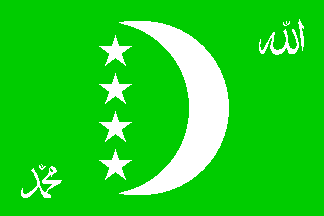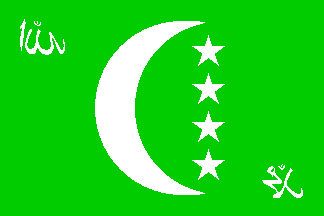
by Arnaud Palac and António Martins,
25 Jan 2000 |

Last modified: 2006-03-18 by antonio martins
Keywords: comoros | star: 5 points (white) | islam | stars: 4 | stars: line | ullam | allah | مهمّد | muhammad | اللّه | law | crescent: points to fly (white) |
Links: FOTW homepage |
search |
disclaimer and copyright |
write us |
mirrors
 by Arnaud Palac and António Martins, 25 Jan 2000 | |
This flag was adopted at the
same time as the new constitution of the country, 3 October
1996, which was replaced by referendum
in late 2001.
Jos Poels and Mark Sensen, 05 Apr 1997
In September 1995, Bob Denard overthrew Dzohar and tried to establish
a kind of personal Kingdom, but he was definitively expelled from the
Comoros by the French Army. Dzohar came back to the Comoros in March
1996 and helped to the election of President Mohammed Taki Abdul Karim.
The constitution of 20 October 1996 prescribed a new national flag.
Ivan Sache, 20 Apr 2002
The green colour and the crescent are symbols of
Islam. The four stars represent the 4 islands of
the Comoros group, even
though one of these, Mayotte,
is a French territory. With the exception of the
Socialistic red,
the symbolism of the flag has remained consistent.
Stuart Notholt, 22 May 1997
According to all information gathered till now
the flag is green, with a white crescent and ditto
four stars between the horns on a vertical line in the middle
of the flag. There are white, arabic inscriptions in the
upper fly corner and lower hoist corner. The proportions of
the flag are 21:15. (Source: Pierre Germain, from the french
military assistance mission in the Comoros, by way of Armand
du Payrat)
Jos Poels and Mark Sensen, 05 Apr 1997
Album 2000 [pay00] says:
1. National Flag.Two images showing the 1996 flag contating the two names. They agree much with what we have as variation #2, especially the reverse one.3:5≈
I inspected closely this flag (i.e., held
it in my hands), it’s the newest and is seen all over
the place on official buildings. It’s a lighter green
than the others, but
unfortunately I didn’t have time to find out who made
it and on whose instructions. It may reflect the change
of government earlier this year, although there has
been no new constitution.
This new light-green flag is quite rectangular,
probably 2:3. If it’s not 2:3, then they’d be a
little squarer, but not much.
Iain Walker, 21 Dec 1999 and 14 Jan 2000
The light shade of green might be due to a particular option of the flag
manufactor who provided for the Government’s laters order, but it was not
specifically legislated, and might be replaced by a darker shade when the
current stock of flags worns out and gets replaced by a shipment from a
different manufactor.
António Martins, 27 May 2001
According to an article in The Flag Bulletin
[smi97b], the latest
(1996) version [see previous]
has the crescent/stars
facing the fly, with the words "Allah" (اللّه)
added to the top fly and "Muhammed" (مهمّد) to
the bottom of the hoist, both in white and in simplified Arabic.
Stuart Notholt, 22 May 1997
This flag doesn’t use “long hand” but the more stylized
ulam (a sort of monogram). Arabic calligraphy is
very flexible and forms a major part of Arabic art and the
ulams have developped as a stylized form of the
names.
Graham Bartram, 23 Sep 1999
According to the presidential decree concerning
the Comoros flag (1996), both inscriptions should include the accents
("shaddas"), and the flag ratio is 2:3.
Jan Zrzavy, 20 Sep 1999 and 21 Nov 1997
Allah is writen with two "L"s (Alif-lim-lim-ha:
اللّه),
but Muhamed got only one "M" in the middle (mim-kha-mim-dal:
مهمّد)
and the shada “duobles” the "M" to become "MoukhaMMed".
Dov Gutterman, 21 Sep 1999
"Allah" takes a shadda on the second "l" because
"l" is a “sun” letter like "s", "n", "d", "r", "z", etc. That
means when you write the basic word for "god" — "lah"
— with the definite article "al" (making it "The [One] God"),
you don’t pronounce the "l" in "al". But to make up
for it, you double the first letter of the basic noun by
giving it a shadda. "The light", written "al nur" thus
is pronounced and marked with diacritics to make it "an
nur". Same for "al lah", or Allah. As for Muhammad,
it has to do with the fact that the linguistic root from which
"Muhammad" is derived is HMD. Arabic is based on triliteral
roots. You can’t correctly write Muhammad MHMMD, only
MHMD. Short vowel and diacritical marks are normally
left off in everyday written Arabic, but if you’re using them,
"Muhammad" must have shadda. Not two "m"s. As I noted before,
the example of Allah doesn’t apply because the first "l" is
part of the definite article "l".
Joseph McMillan, 21 Sep 1999
The 1996 constitution reads:
Art. 2 - L’emblème national est le drapeau vert frappé au centre d’un croissant et de quatre étoiles de couleur blanche avec en haut du nom d’Allah et en bas du nom de Muhammad, son Prophète. Les autres caractéristiques du drapeau sont fixées par la loi.Translated:
Art. 2 - The national emblem is the green flag struck in the centre with a crescent and four stars, white in colour, with above the name of Allah and below the name of Muhammad, his Prophet. The other characteristics of the flag are fixed by the law.Iain Walker, 20 Sep 1999
According to Vexilologie No. 105 [vex] (paper written by Jiri Tenora), the decree of president of the Federal Islamic Republic of Comoros No. 96-001/PR (26 October 1996) includes five articles (attention — multiple translation, at least French-Czech-English):
 by Arnaud Palac and António Martins, 25 Jan 2000 | |
The reverse (face showing when the pole is at the
viewer’s left hand) is a mirror image, that is
Allah top in the hoist and Mohammed bottom in the fly,
but illegible, i.e., reversed — the text is
sewn through the flag.
Iain Walker, 21 Dec 1999
As usual in flags of countries/cultures where
writing goes from right-to-left, the obverse (“main”
side) is considered to be that shown with the hoist
at the viewer’s right hand. It is strange that though the
two previous variations
had correct backsides, the currently used variation is
“wrong”…
António Martins, 13 Jan 2000